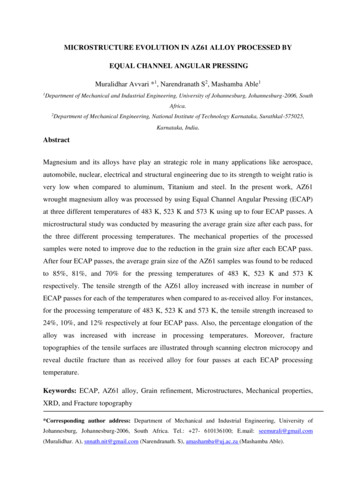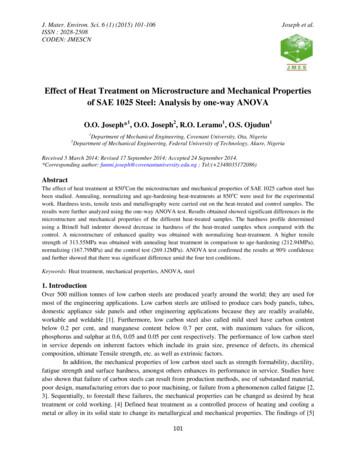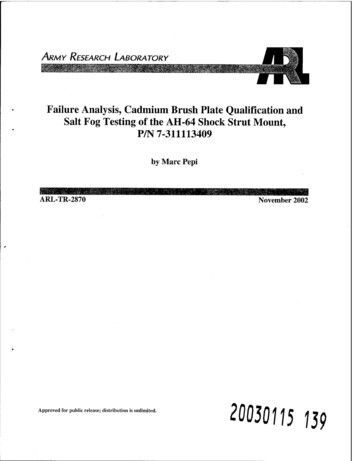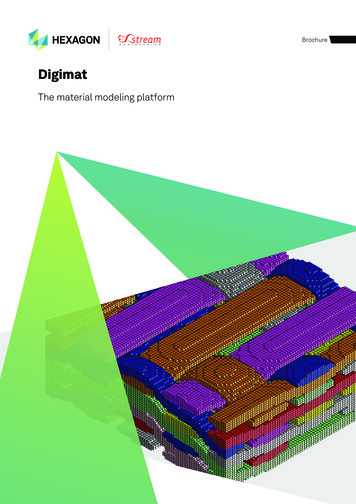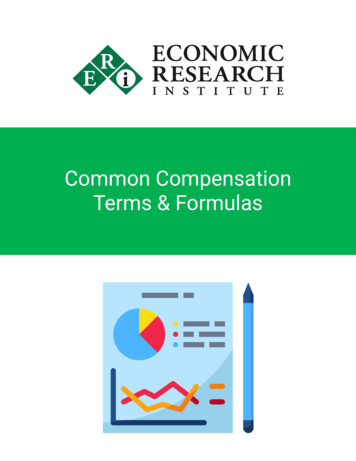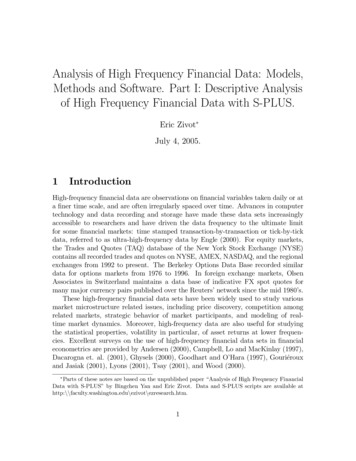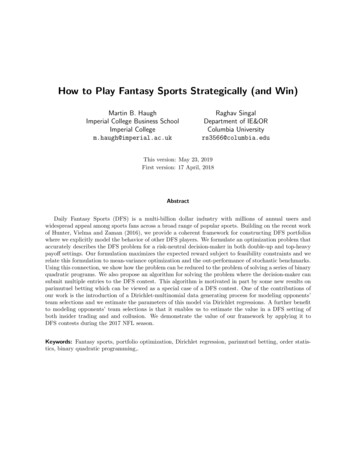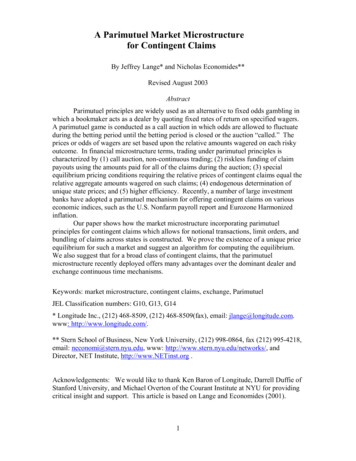
Transcription
A Parimutuel Market Microstructurefor Contingent ClaimsBy Jeffrey Lange* and Nicholas Economides**Revised August 2003AbstractParimutuel principles are widely used as an alternative to fixed odds gambling inwhich a bookmaker acts as a dealer by quoting fixed rates of return on specified wagers.A parimutuel game is conducted as a call auction in which odds are allowed to fluctuateduring the betting period until the betting period is closed or the auction “called.” Theprices or odds of wagers are set based upon the relative amounts wagered on each riskyoutcome. In financial microstructure terms, trading under parimutuel principles ischaracterized by (1) call auction, non-continuous trading; (2) riskless funding of claimpayouts using the amounts paid for all of the claims during the auction; (3) specialequilibrium pricing conditions requiring the relative prices of contingent claims equal therelative aggregate amounts wagered on such claims; (4) endogenous determination ofunique state prices; and (5) higher efficiency. Recently, a number of large investmentbanks have adopted a parimutuel mechanism for offering contingent claims on variouseconomic indices, such as the U.S. Nonfarm payroll report and Eurozone Harmonizedinflation.Our paper shows how the market microstructure incorporating parimutuelprinciples for contingent claims which allows for notional transactions, limit orders, andbundling of claims across states is constructed. We prove the existence of a unique priceequilibrium for such a market and suggest an algorithm for computing the equilibrium.We also suggest that for a broad class of contingent claims, that the parimutuelmicrostructure recently deployed offers many advantages over the dominant dealer andexchange continuous time mechanisms.Keywords: market microstructure, contingent claims, exchange, ParimutuelJEL Classification numbers: G10, G13, G14* Longitude Inc., (212) 468-8509, (212) 468-8509(fax), email: jlange@longitude.com.www: http://www.longitude.com/.** Stern School of Business, New York University, (212) 998-0864, fax (212) 995-4218,email: neconomi@stern.nyu.edu, www: http://www.stern.nyu.edu/networks/, andDirector, NET Institute, http://www.NETinst.org .Acknowledgements: We would like to thank Ken Baron of Longitude, Darrell Duffie ofStanford University, and Michael Overton of the Courant Institute at NYU for providingcritical insight and support. This article is based on Lange and Economides (2001).1
ContentsI. Introduction. 3II. Parimutuel Microstructure and Market Games. 4III.Parimutuel Microstructure for Contingent Claims . 12A. Development of the Parimutuel Microstructure: Definitions and Setup . 13B. Parimutuel Equilibrium Pricing Conditions . 17C. Parimutuel Limit Order Book Equilibrium . 211.Limit Order Book Equilibrium . 212.An Example of Limit Order Book Equilibrium. 23III.Parimutuel Microstructure: Arbitrage and Efficiency Considerations . 25A. Risk Neutrality . 26B. Arbitrage-free Claims . 27C. Efficiency of Parimutuel Price Discovery . 28D. Price Uniqueness. 29E. Multilateral Order-Matching. 31F. Information Production. 32IV.Conclusion . 32V. References. 34VI.Appendix. 372
A Parimutuel Market Microstructurefor Contingent ClaimsIntroductionI.Parimutuel principles were invented in late 19th century France by Pierre Oller asan alternative to the bookmaker syndicates that dominated French gaming at the time.The parimutuel mechanism supplanted bookmaker horse racing in the United Statesbeginning in the 1920’s and 1930’s facilitated in large part by the invention of theautomatic odds calculator (or “totelizator”) by Harry Strauss.1Recently, a number of large investment banks have adopted a parimutuelmechanism for offering contingent claims on various economic indices, such as the U.S.Nonfarm payroll report, Eurozone Harmonized inflation, and Fannie Mae mortgage poolprepayment speeds. The parimutuel mechanism employed is a call auction lasting aboutone hour for claims on the underlying index which include a variety of standard andexotic derivatives, including vanilla call and put options, forwards, digital options, rangebinary options, and linked buy/sell options such as risk reversals. A unique feature of themicrostructure is that all of the claims offered are priced in equilibrium based upon animplementation of parimutuel mechanism principles. Our aim is to formalize theseprinciples and point out some of the inherent advantages of the mechanism as applied tothe recent auctions.As a market microstructure, the parimutuel mechanism has four distinguishingfeatures: (1) the parimutuel mechanism is a call auction market rather than a continuousauction; (2) relative prices of contingent claims are equal to the relative aggregate cost ofsuch claims; (3) the total amount paid for the contingent claims is exactly sufficient topay for the contingent claims having a positive return, that is, the mechanism is selffunding and risk-neutral in the sense that the total premium paid for contingent claims isequal to the state contingent payouts for all contingent claims expiring “in-the-money2;(4) a unique set of endogenously determined prices is discovered; and (5) higherefficiency than other trading mechanisms.1Considerable empirical work has been done on the efficiency and information characteristics ofparimutuel wagering. See Haush, Lo, and Ziemba (1994).2In this paper, we ignore transaction costs which can be quite significant in parimutuel gambling contexts.3
Our approach is to formally provide a foundation for the parimutuel mechanismand then describe in detail the mechanism recently employed in the capital markets. Ourfirst step then is showing a foundational connection between parimutuel principles andthe theory of market games. In Section II, we show that a parimutuel contingent claimsmarket is a natural extension of a Shapley-Shubik market game for contingent claims.3Thus, we connect the parimutuel mechanism to the well-developed market gamesliterature and show that a parimutuel mechanism is a viable mechanism for a contingentclaims market with endogenous price formation. In Section III, we discuss in detail theparimutuel market microstructure recently employed to offer contingent claims on theEurozone inflation index, U.S. economic statistics such as the nonfarm payroll releases,Fannie Mae mortgage pool prepayment speeds and other indices. We show that theparimutuel microstructure with notional claims, limit orders, and “claim bundling” acrossstates has a unique price equilibrium. We also present a theorem which shows that allparimutuel mechanisms can be expressed as a solution to a general eigenvalue problem.Section IV discusses the efficiency and no-arbitrage characteristics of the parimutuelmicrostructure as applied to the capital markets. In particular, we show that the liquidityaggregation features of the parimutuel microstructure, both across time in a call auctionand across disparate types of contingent claims, can reduce the amount of noise aroundthe fair price of such claims. Section V concludes.Parimutuel Microstructure and Market GamesII.Parimutuel principles are widely used as an alternative to fixed odds gambling inwhich a bookmaker acts as a dealer by quoting fixed rates of return on specified wagers.A parimutuel game is conducted as a call auction in which odds are allowed to fluctuateduring the betting period until the betting period is closed or the auction “called.” Theprices or odds of wagers are set based upon the relative amounts wagered on each riskyoutcome. In microstructure terms, wagering under parimutuel principles is characterizedby (1) call auction, non-continuous trading; (2) riskless funding of claim payouts usingthe amounts paid for all of the claims during the auction; (3) special equilibrium pricingconditions requiring the relative prices of contingent claims equal the relative aggregate3See Shapley and Shubik (1977).4
amounts wagered on such claims; and (4) endogenous determination of unique stateprices.When applied to the theory of contingent claims markets, the self-funding andrelative pricing features of a parimutuel system result from the guaranteed existence of apositive state price vector, p, which excludes arbitrage over the state space.4 The vectorp contains the prices for each elemental state outcome.We will show that the existence of the positive state price vector combined withenforcing the equality of the aggregate payouts for each state are sufficient to guaranteethat contingent claims are both self-funding and that the relative prices of claims areequal to the relative amounts paid for such claims. Assuming no transaction costs, andfor purposes of this discussion, zero interest rates, the absence of arbitrage requires thefollowing normalization condition on the state prices:pT e 1, p 0 ,(1)where p is a strictly positive S-dimensional vector of state prices (probabilities), e is anS -dimensional unit vector, and superscript T is the familiar transpose operator.Multiplying by a vector y, an S -dimensional vector containing the aggregate statepayouts for each state, yields the riskless condition that all payouts are identical acrossthe states:(y T p)e y(2)Since the left-hand side of (2) is a vector containing the aggregate premium investment,(2) states that the state contingent payout of each state is equal to the aggregate premiuminvestment, i.e., that total amounts paid for all of the contingent claims are equal to thetotal contingent payouts. And since there is no arbitrage, the pricing system is linear, sothat clearly:psy p(y T p) p s s s Ts, k 1, 2, . . . , Spky k p k (y p) p k4(3)We employ the term state space to include the usual formalism, i.e., a set Ω contains an algebra ofevents, F, for which there exists a probability measure P: FÆ [0, 1] satisfying P(Ø) 0 and P(Ω) 1 andfor any disjoint events A and B:P ( A B ) P( A) P( B) .The triple (Ω, F, P) is called a probability state space, or “state space.” See Duffie (1992), Appendix A.5
where ps and ys are the s-th elements of the vector p and y, respectively. This conditionstates that the relative prices of each fundamental state contingent claim is equal to theaggregate relative amounts paid for the respective claims.In addition, parimutuel principles include a market structure for arriving at theequilibrium prices in which state prices are discovered endogenously via a call auctionprocess. It is the endogenous nature of the price discovery which provides a fundamentalconnection of parimutuel principles, “market games” to be discussed next, and thecontingent claims and market microstructure research.The seminal paper of Arrow (1964) demonstrated the equivalence of acompetitive exchange economy for contingent commodities with an economy which hasa complete and competitive securities market and a spot market in the commodities. Inthis competitive analysis, the securities market has contingent claims prices which arefixed exogenously. Since prices are fixed, each agent’s demand has a negligible effect onthe price. Subsequent research has shown that this equivalence result depends cruciallyon the competitive nature of the securities markets. For example, Peck, Shell, and Spear(1992) show that if the securities market is modeled using a noncooperative market gamewith endogenous price formation, then the Arrow equivalence result no longer holds. Seealso Weyers (1999).The market microstructure literature is largely concerned with endogenous priceformation where each agent’s demand has a potentially significant impact on the marketprice. Outside the finance literature, there exists a large body of research utilizing thetheory of noncooperative market games to model endogenous price formation. Aninfluential paper by Shapley and Shubik (1977) introduced a noncooperative marketgame for a market with commodities and fiat money but with no uncertainty. In theShapley-Shubik market game (“SSMG”), each trader consigns his endowment of eachcommodity to a trading post dedicated to that commodity. Trade occurs with each traderbidding some of his fiat money to each trading post. When the trading period ceases, theequilibrium price of each commodity is the sum of all the bids in fiat money committedto a trading post divided by the total quantity of commodity consigned to that post. Eachtrader receives an amount of goods resulting from his bid of fiat money equal to his biddivided by the equilibrium price. Shapley and Shubik (1977) and subsequent papersshow that an interior Nash Equilibrium (“NE”) always exists and that the NE converges6
to a competitive equilibrium as the economy is replicated. See, for example, Powers,Shubik, and Yao (1994).The SSMG framework has been applied to markets with uncertainty by Peck,Shell, and Spear (1992) and Weyers (1999) as indicated above. Our intent here is toanalyze an SSMG market adapted to contingent claims over a state space, i.e., we areinterested in the securities market microstructure which may be generally applicable toderivatives and other contingent claims markets. We first show that the SSMG marketgame with a credit policy restriction on selling is a parimutuel market microstructure.The credit policy, which is defined further below, requires that selling be done on asecured or collateralized basis.Proposition 1: A Shapley-Shubik market game for contingent claims within aprobability state space with secured selling is a parimutuel market.Proof: The following notation is required:J agents indexed j 1, 2, , J;S states indexed s 1, 2, , S;wj(o), initial wealth of agent j;wsj(f), final wealth of agent j in state s;bsj, agent j’s bid in dollars for state contingent claim s;xsj, agent j’s offer in dollars for insuring contingent claim s; andps, price for state s.First we define the Shapley-Shubik market game model. In the SSMG model,each trader makes bids and offers to each trading post, where each trading postcorresponds to a contingent claim within a probability state space. As in the classicalSSMG, prices are equal to the ratio of total money bids divided by total commodityconsignments or offers for each trading post. For a contingent claims market using theabove notation, endogenous price formation therefore takes the following well-knownfunctional form7
J bj 1ps jsJ xj 1.(4)jsEach state contingent claim price is therefore the sum total of bids in units of money(e.g., dollars) divided by offers in units of money. The offers can be interpreted as salesof the contingent claim, or offers to payout 1 unit of state contingent insurance should thestate corresponding to the trading post be realized.Based upon the preceding notation, the budget constraint for agent j is thereforeSSs 1s 1wsj ( f ) w j (o) bsj x sj p s bsj x sj , s 1,2, ., S.ps(5)We assume interest rates are zero and there is no production. Thus, the initial andfinal wealth in the economy are equalJJJSJj 1j 1j 1 s 1Jbsj xsj 0, j 1, 2,., Jj 1 p sj 1SJ wsj ( f ) w j (o) bsj xsj ps j 1 s 1(6)as implied from the definition of price ps,Jbsj x sj 0, s 1,2, ., S . pj 1j 1sJ(7)We refer to this condition as the market clearing condition. Summing over s yields theinitial (i.e., at the time of premium settlement) market clearing condition that totalpremiums paid equal total premiums sold, or:JSJS b xj 1 s 1jsj 1 s 1jsp s 0.(8)Since all the states comprise a state space, it is required that:JSS p s 1ss 1 bj 1J xj 1js 1.(9)jsClearly, nothing so far developed prevents sellers of claims (i.e., sellers of“insurance”) from defaulting. To address the possibility of default, we assume that themarket imposes the following credit restriction on offers of notional insurance.8
Define a credit policy as follows: Total offers of notional insurance for any statemust be secured by at least the total premiums sold for all of the states, i.e.,JJSj 1j 1 s 1 xsj xsj ps , s.(10)Substituting from the market clearing condition, yields:JSbsj bsj , s 1,2, ., S pj 1j 1 s 1sJ(11)which yieldsJ bj 1JjsS bj 1 s 1 p s , s 1, ., S .(12)jsSince the states comprise a probability state space,S ps 1 1.s(13)Thus, it must be the case thatJ bJj 1Sjs bj 1 s 1js ps , s 1, ., S ,(14)which states that the price of each state is equal to the total bids for that state divided bythe total bids for all of the states. Thus, the equilibrium pricing condition for theShapley-Shubik market game for contingent claims requires the relative prices ofcontingent claims to equal the relative aggregate bids for the respective claims. Since theSSMG is also a call auction market which is self-funding with endogenous pricedetermination, the SSMG for contingent claims is parimutuel.We can also interpret Proposition 1 in the following way. Each trader who makesan offer for a contingent claim (i.e., a sale of notional insurance) is required to postmargin. The margin amount is equal to the premium proceeds. This is a standardpractice at most options exchanges and is known as premium margin. Proposition 1requires that the total amount of notional insurance on offer for any state cannot exceedthe total premium margin deposited. At most options exchanges, an additional amount ofmargin related to the risk of the option sold is also required (oftentimes known as9
additional margin as is the case at Eurex Clearing A.G., the clearinghouse for the Eurexexchange). As no additional margin is required by Proposition 1, we interpret the creditpolicy to be not overly tight, especially as compared to existing margin mechanisms inuse.Proposition 2: The credit policy constraint requiring the total notional offers ofinsurance for any state not exceed the total premiums sold can always be satisfied, i.e., itis never binding.Proof: It can easily be shown that any notional sale can be replicated through apurchase of complementary states within the state space over which claims are traded sothatJ xj 1jsJSJS x sj p s bsj , s.j 1 s 1(15)j 1 s 1Consider a notional sale wherex sj 0 and x kj 0 for s k .(16)In this case, agent j sells a claim on state s and on no other state. We use the termreplicated sale to denote the strategy of bidding on the complementary states to state s inthe following way5:bsj 0 and x kj pk x kj for s k .(17)The bid on the s-th state of the replicated sale is 0, whereas bids on all other states arenon-zero. To ensure the replication is available, we allow the trading post for each statecontingent claim to open with an arbitrarily small bid and offer, i.e.,ε s (b ) 0, ε s ( x ) 0, s 1,2, ., S ,(18)where the arguments b and x indicate the small amounts of existing bids and offersallocated to each state, where these amounts are vanishingly small.6 In equilibrium, theprofits of a replicated sale are identical to those of the original notional sale,5We note that bidding on all of the states proportional to the price achieves the “autarky” strategyof effecting no change in each agent’s endowments. See Peck, Shell, and Spear (1992).10
wsj ( f ) w j (o) p s x sj wsj (o) x sj (1 p s ),s kwjs k( f ) w (o) p s x sj x sj w j (o) x sj p sj(19)s ki.e., the final wealth from the replicated sale is identical to the original notional sale foreach state. Any notional sale can therefore be replicated into a complementary bid whichsatisfies the credit policy, and therefore replicated sales are payout-achievable.We have yet to show that an equilibrium exists with such replication going onduring the auction. We turn to this next, and show that any arbitrary number ofreplications has a fixed-point equilibrium.Proposition 3: A unique parimutuel equilibrium exists with replicated saleswhich are used to satisfy the credit policy.Proof: Consider a notional sale wherexsj 0 and xkj 0 for s k .As indicated above, the replicated sale strategy isbsj 0 and x kj p k x kj for s ksuch that the strategy bid for s k is as follows:Jbsj bjsjJSjs bx sj g (bsj ).(17)jsBy the Banach Fixed Point Theorem, there exists a fixed point strategy bid for thedifferentiable function g if there exists a constant z 1 such thatg ′(bsj ) z.(18)Differentiation of g (bsj ) yields:g ′(bsj ) JSJjsJSjs bsj bsjj( b )j 2sxsj .(19)From the market clearing condition, above,6These small liquidity amounts take the place of the usual SSMG convention that the quantity 0/0owing to zero bids and offers is equal to 0.11
JJSj 1jsxsj xsj bsj .(20)Together with the obviousJSjsJ bsj bsjjJSjs b 1(21)jscompletes the proof. Uniqueness follows from the contraction property of the mappingthat leads to the fixed point.Proposition 4: The SSMG and a parimutuel market have equivalent payouts andfirst-order optimality conditions.Proof: See the appendix.7The first order conditions for the SSMG equilibrium can readily be shown to be: 1 jjq s u ′( ws ( f )) p s q kj u ′( wkj ( f )) p k 1 bsjBsjbkjBkj (22)which shows that the ratio of expected marginal utilities is equal to the ratio of statecontingent prices, i.e., the competitive Arrow-Debreu economy result, multiplied by theterm in brackets. These are the same oligopoly conditions derived in Shapley-Shubik(1977). The oligopoly conditions depend on the ratio of the size of trader i’s bid in eachstate to the total amount of bids in that state excluding trader i’s bid. They thereforemeasure the market’s ability to absorb trader i’s bid strategy. As trader i’s bid strategybecomes smaller relative to the total bids on each state, the market approaches thecompetitively optimal marketIII.Parimutuel Microstructure for Contingent ClaimsIn this section we describe the parimutuel microstructure recently used to auctionoff claims on U.S. economic data releases such as nonfarm payrolls, retail sales, andproduction indices as well as the Eurozone Harmonized inflation index (ex tobaccoprices) and Fannie Mae mortgage pool prepayment speeds. Our goal is to show that theparimutuel market has been designed in a manner which yields contingent claims familiar7Rather lengthy proofs are available at the Appendix.12
to market participants in existing derivatives markets. For example, one feature of theparimutuel market microstructure is that all trading strategies are implemented with bidsand offers of notional amounts of risky claims. In the Shapley-Shubik contingent claimsmarket game of Section II, agents implement strategies with offers of notional insurancexsj and bids of premium dollars, bsj. Conventionally, however, derivatives contracts arebased upon the notional amount to be bought or sold and not denominated in premiumdollars. The purchaser of an option, say on the dollar-yen foreign exchange rate, willspecify a desired size of the position in notional terms, e.g., 10 million dollars, rather thanin terms of the amount of desired premium outlay.We show next that the parimutuel microstructure allows trading strategies to beimplemented with limit orders, whereby a trader may specify a reservation price above(below) which the specified purchase (sale) of a given contingent claim will not beexecuted. Limit prices have heretofore not been used in parimutuel games.A.Development of the Parimutuel Microstructure: Definitions and SetupIn this section, we develop the concepts and mathematical notation needed toadequately describe the parimutuel contingent claims microstructure recently used in thecapital markets in which trader strategies can be implemented with (1) a notional buy orsell order; (2) a vector of payout ratios corresponding to a range of states (claimbundling); and (3) a limit price.To begin, we let U denote the value of an underlying variable selected for aparimutuel auction—for example, this variable may be the value of an upcoming releaseof an economic statistic such as Eurozone Harmonized Inflation index. Before the startof the auction, the strikes for the options to be traded on the underlying are determined.The option strikes are set across the range of likely outcomes of the underlying tomaximize interest in the claims being offered. Let k1, k2, . . . , kS-1 denote the optionstrikes and letk1 k2 . . . kS-1(23)assuming, for simplicity, that the underlying U cannot take on any values between anytwo strikes. These S-1 strikes divide U into S states as shown in the first two columns of13
Table 1. Associated with each of these S states are S state contingent claims that pay outif and only if that particular state occurs.Prior to the opening of the parimutuel call auction, the financial intermediaryhosting the auction enters orders for each of the S state contingent claims. We refer tothese orders as the opening orders. Let the opening order premium be denoted as θs fors 1, 2, , S such thatθs 0s 1, 2, . . . , S(24)Though opening orders can be small relative to the customer orders, opening ordersensure that the parimutuel equilibrium prices are unique.Table 1. The states, outcomes, and state contingent claims in a PDCA auction.StateOutcomeState Contingent Claim12.s-1Ss 1.S-1SU k1U k1.U ks-2U ks-1U ks.U kS-2U kS-1Digital put struck at k1Digital range with strikes of k1 and k2.Digital range with strikes of ks-2 and ks-1Digital range with strikes of ks-1 and ksDigital range with strikes of ks and ks 1.Digital range with strikes of kS-1 and kS-2Digital call struck at kS-1In the parimutuel market recently run on Eurozone inflation, customers submittedoption orders to buy or sell options following standard option market protocols. Fornotation, assume that customers submit a total of J orders in the auction, indexed by j 1,2, . . . , J. When submitting an order, the customer requests a specific number ofcontracts, denoted by rj. For digital options, we adopt the convention that one contractpays out 1 if the digital option expires in-the-money. For vanilla options, we adopt theconvention that one contract pays out 1 per point that the option is in-the-money. Theparimutuel mechanism is novel with respect to existing parimutuel wagering schemes inthat customers can specify a limit price for each order, as is done at exchanges includingthe New York Stock Exchange and the Chicago Board of Trade, i.e., the limit price for apurchase of an option represents the maximum price the customer is willing to pay for the14
option specified. The limit price for a sell of an option represents the minimum price atwhich the customer is willing to sell the option. We use wj to denote the limit price forcustomer order j.The parimutuel mechanism replicates each option using the auction’s statecontingent claims. For notation, let aj,s represent the notional payout amount of statecontingent claim s used to replicate customer order j. Recall, for instance, from Table 1that the first state contingent claim is the digital put struck at k1. Therefore, aj,1 is thenotional amount of the digital put struck at k1 used to replicate order j. We require aj,s tobe non-negative, and we refer to the vector [aj,1, aj,2, . . . , aj,S] as order j’s replicationweights.The mechanism determines the replication weights to match order j’s payouts.For example, a digital call pays out a fixed amount if, upon expiration, U is greater thanor equal to its strike, denoted as kv. If order j is a buy order for this option, then thereplicating weights are 0a j,s 1s 1, 2, . . . , vs v 1, v 2, . . . , S(25)This set of state contingent claims pays out if U is greater than or equal to kv, matchingthe payouts of the digital call. If order j is a buy of a vanilla call spread with strikes kvand kw with kv kw, then the replicating weights are8a j ,s 0 k s 1 k v k kv ws 1, 2, . . . , v 1s v 2, v 3, . . . , w(26)s w 1, w 2, . . . , SFor a sell of digital call option struck at kv, the customer profits if U is less than kv atexpiration. In this case,8If the underlying U can take on values between adjacent strikes, then the replicating weights for a vanillacall spread become 0 a j ,s E[U k s 1 U k s ] k v k kv ws 1, 2, . . . , vs v 1, v 2, . . . , ws w 1, w 2, . . . , SIn this case, the replicating weights are based on the conditional expected value of the underlying.15
1a j ,s 0s 1, 2, . . . , vs v 1, v 2, . . . , S(27)The mechanism replicates other options, such as digital puts and vanilla put spreads in asimilar fashion.Let ps denote the equilibrium price of the sth state contingent claim for s 1, 2,., S. such that the price of each state contingent c
binary options, and linked buy/sell options such as risk reversals. A unique feature of the microstructure is that all of the claims offered are priced in equilibrium based upon an implementation of parimutuel mechanism principles. Our aim is to formalize these principles and point out some
